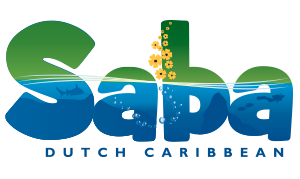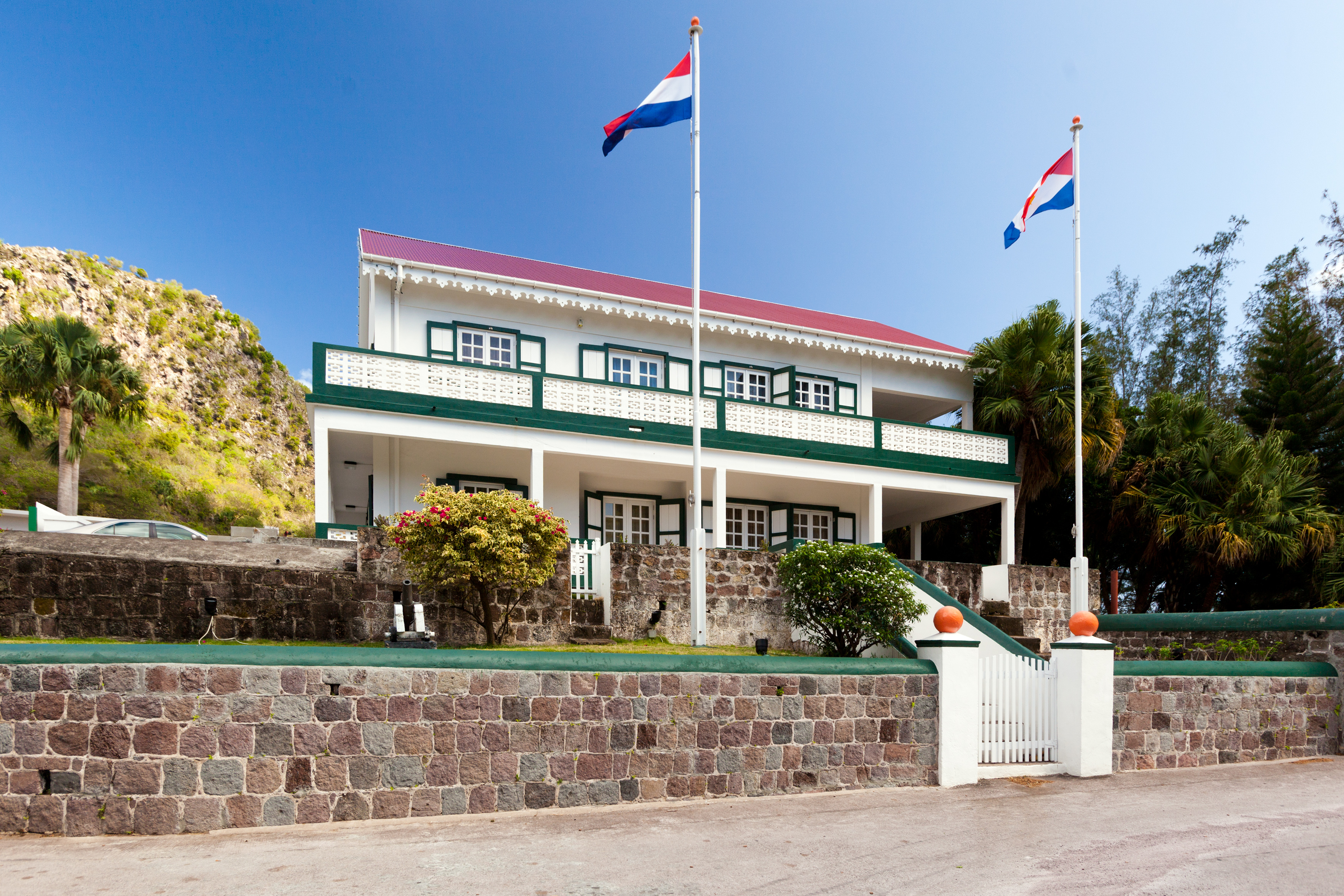Saba is a five square mile island located in the northeastern Caribbean Sea, 28 miles southwest of its international hub St. Maarten, a 12 minute flight or 90 minute ferry ride away. Formerly part of the Netherlands Antilles, in 2010 Saba became part of a special municipality of the Kingdom of the Netherlands, along with the islands of St. Eustatius and Bonaire.
Saba has four main villages, The Bottom (Saba's capital), Windwardside, St. John's and Zion's Hill (aka Hell's Gate). All are well kept and bristling with old Caribbean charm. Gingerbread houses with immaculate gardens, and clean and safe streets await your exploration.
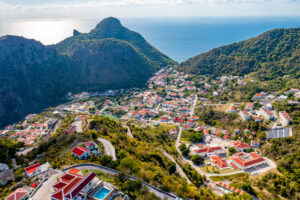 The Bottom
The Bottom
The Bottom is Saba's capital and home to Saba University School of Medicine. (Medical students and faculty make up almost a quarter of the island's entire population.) You'll also discover several small restaurants, bars and grocery stores in the village. Drive to Well's Bay and see the old Customs House that sits atop "The Ladder," the rugged steps that formed Saba's route to and from the sea long before the road was built. Climb up and down the steps once and you'll get a true appreciation of how tough life was for early Sabans.
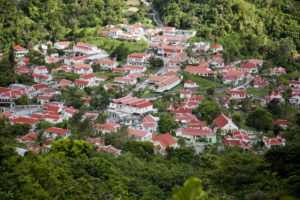 Windwardside
Windwardside
Windwardside is the most tourist-oriented village. Drop by the Saba Tourist Bureau and say hello, you'll be within close proximity to three of the island's hotels and home to many vacation rental cottages. You'll have no trouble passing a day wandering through small streets, exploring the museums and shops, and a bite to eat is never far away. If you're up for some exercise stop by the trail shop, pick up a map and a keepsake and then ascend the Mt. Scenery Trail to climb to the highest point in the Kingdom of the Netherlands!
St. John's 
St John’s is one of Saba’s smaller villages. Before entering our Capital, The Bottom, you must drive through this quaint neighborhood. Here you can ask your Taxi to make stops to capture some of our best scenic shots on the island. On a very clear day, you can see our neighboring islands St Eustatius, St Kitts, Nevis and, if you’re lucky, even Montserrat! From this vantage point high above the Caribbean Sea, ships and boats can be seen coming and going to Fort Bay Harbor. St. John’s played a big role in the island’s history. If a vessel was approaching someone from the village would signal to residents in The Bottom to let them know visitors would soon arrive. Be sure to check out Crispeen Track, it will certainly take you back in time and give you a real feeling of the old St John’s.
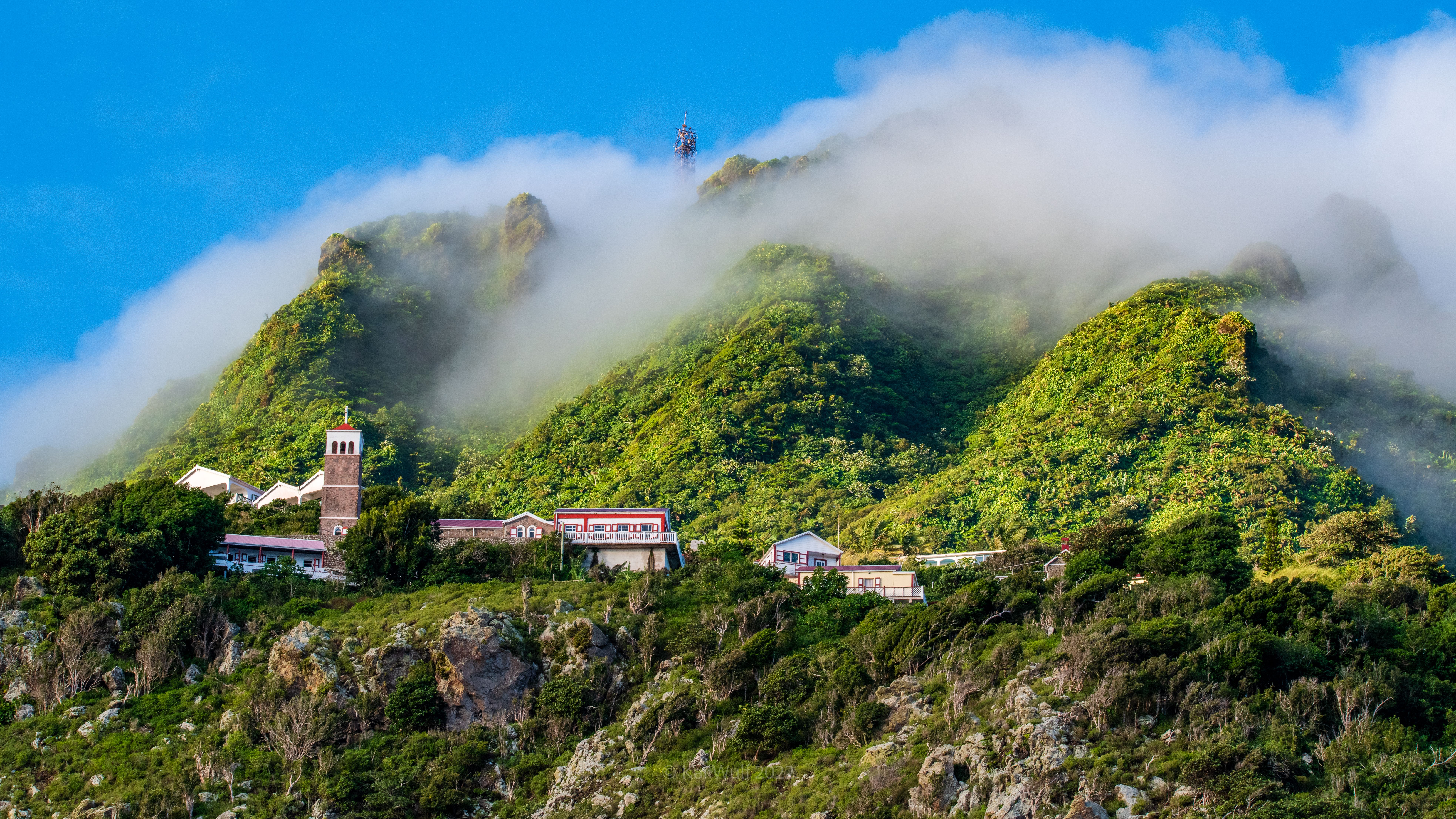 Zion's Hill (A.k.a. Hell's Gate)
Zion's Hill (A.k.a. Hell's Gate)
Zion's Hill is the first town you'll reach after leaving the Juancho E. Yrausquin Airport. Hell's Gate was officially named "Zion's Hill" after complaints from the church forced the Island's government to change the name. However, "Hell's Gate" is still used by many Sabans and visiting tourists today. Hell's Gate is home to the Holy Rosary Church, a stone structure built in 1962. Hell's Gate is about 1000 feet above sea level. Lower Hell's Gate is home to a now-closed sulfur mine where visitors may explore with caution. Hell's Gate is also the start of the Sandy Cruise trail which one can take. The trail takes roughly 2 hours to complete and gives stunning views of Diamond Rock and the Saban coastline.
Visa Requirements
Click here for detailed Visa information tourist/business visits to the islands of the Dutch Caribbean.
All travel to Saba connects in St. Maarten.
Several major airlines from North America, Europe and South America carry daily flights into St. Maarten's Princess Juliana International Airport (SXM). Special charter flights are also available from major cities during the winter season. There are currently two airlines and two ferry services that operate schedules to Saba's shores from her international hub.
Departure Tax: An Airport and Harbor departure tax fee of $10.00 is payable when departing Saba. There are no ATM's at the airport and harbor.
By Air from St. Maarten:
WINAIR
Winair makes four or more daily flights to Saba to Juancho E. Yrausquin Airport. Inter-island flights can be arranged, some are scheduled weekly.
Book On-line Here.
Johnson's Travel Services (On-Island WINAIR Agent)
Located on Saba, Johnson's Travel Services can answer your questions about prices, schedules and provide other helpful information about traveling to Saba with WINAIR.
Juancho E. Yrausquin Airport
Flat Point
Saba, Dutch Caribbean
Tel: +599 416-2255
Email: winairsab@gmail.com.
Windward Express Airways (Private Air Charters)
Established in 2000 Windward Express Airways has become a leader in the private charter travel industry. Flying on the client's schedule and destinations on time while avoiding air terminal check-in, line-ups and lost luggage. From a short flight to a personal itinerary, Windward Express Airways provides direct full access to international, regional and restricted airports (Saba, St. Barths, Baillif, Le Saints). Check with Windward Express Airways first.
Web: windwardexpress.com
SXM Airways (Private Air Charters)
Princess Juliana International Airport
Simpson Bay Sint Maarten, Dutch Caribbean
Tel: +1 (721) 520-1314
Email: charters@fly-sxmairways.com
By Sea from St. Maarten
Makana Ferry: A gift to Saba & Statia
A new ferry service that is providing connections between Saba, St. Maarten, Statia, and to St. Kitts.
The Makana Ferry features a fully air conditioned upper and lower decks with passenger cabins, outdoor seating area, and lots of space for luggage and dive gear.
For bookings, please contact the following agents:
Contact Agent: Jaime Buchanan
Saba C-Transport, N.V.
Windwardside, Saba
Dutch Caribbean
+599 416 2299 (WhatsApp)
Direct from the USA: (607) 8 -GO-SABA
Email: info@sabaferry.com
The Edge
Travels to Saba from Sint Maarten (from Simpson Bay/Pelican Marina) on Wednesday, Friday and Sunday,
For up to date schedule and pricing information visit St. Maarten Activities or contact Saba's on-island agent, Sea Saba.
Charters are also available for private groups. The capacity is 62 passengers.
Email: info@stmaarten-activities.com or info@seasaba.com - ask about their discounted inclusive price for ferry, diving, lunch and more.
Website: www.stmaarten-activities.com
History & Culture
400,000 BC
The island of Saba is the top of a volcano that became active during the middle or late Pleistocene era. Saba is technically a dormant volcano but has no erupted for about 5,000 years. However, there are traces of pyroclastic flows from the 17th century.
Circa 1175 BC
Hunter- gatherers called the Ciboney, are the earliest settlers on Saba. They lived near Fort Bay where recent radiocarbon samples show that the settlement site is over 3,000 years old.
Circa 800 AD
The Arawak Indians migrated into the Caribbean basin from South America and built villages on Saba. They took shelter in caves and many artifacts including pottery, shell tools, and carved stone tools have been found in the Spring Bay area. The Carib Indians were also on Saba, but the Arawak’s probably preceded the Caribs and survived their onslaught.
Circa 1493
Christopher Columbus sighted Saba but sailed on by without attempting any sort of landing due to the treacherous nature of the jagged volcanic shores. Saba remained part of the Spanish Empire for almost 150 years until 1627 when French Adventurers arrived Later in 1629, English pirates started exploring all the Caribbean islands for settlements.
Circa 1632
The island welcomed the first European visitors, a group of shipwrecked Englishmen, they reported later that the island was inhabited. Recently found artifacts revealed the existence of Amerindian settlements.
Circa 1640
The Dutch West Indian Company, which had already settled on the neighboring island of St. Eustatius (known then as “The Golden Rock” as it was thriving regional center of commerce) brought people over to Saba to colonize the island. Soon after, those Dutch men were chased away by the famous British pirate Henry Morgan, due to the ongoing conflict between the Netherlands and Britain.
For almost 200 years the island changed hands between the Dutch, Spanish, French, and English. During this period the Bottom was the first established village on Saba. Situated 1200 feet above Fort Bay, the village is now the administrative center and capital of Saba.
Circa 1816
Although most Sabans are descendants of the English and Irish, it was Holland that finally took possession of Saba. Like everywhere else in the Caribbean, the tragedy of slavery brought people of African descent to Saba’s shores, because life on the island was hard and all had to work together to survive, slavery on Saba ended far in advance of other parts of the world.
During the early to mid-1800’s, most of the male population went to sea and became highly skilled fishermen and seamen. They were often gone for so long that Saba became known as the “Island of Women.” For many years Saba was known as a haven for Caribbean pirates, including the famous Hiram Beakes who once quipped “Dead men tell no tales”. Until well into the 20th century, most men fished or sailed on Saban vessels all over the Caribbean. They brought much needed money to the local economy. Others farmed plots of land on the mountain slopes, where conditions were suitable for agricultural activity.
Circa 1884
With most of the men away from the island, Saba’s women became very resilient and independent by necessity. Their renown grew for making socks, shoes, belts, gloves, Panama style straw hats and what is now known a Saba Lace.
Originally known as Spanish Work, Sabans made it their own and Saba Lace is still created and can be purchased in several locations around the island today.
Circa 1887
The McNish Sulphur Mining Company begins mining on Saba, employing over 100 Sabans. However, the mining venture ended within a year. The mine and the sulfur oven still exist.
The Twentieth Century
In 1909 A navigational school was established by Frederick Simmons to train young Saban men in the ways of the sea.
Until 1943, transportation on Saba was not easy, steep trails between the sea and the settlements on the hills were negotiated on foot and donkey. Finally, in 1943, Josephus "Lambee" Hassell achieved the road that, Dutch & Swiss engineers claimed, "couldn't be built". Hassell simply took a correspondence course in civil engineering and started to build the road with the help of his fellow islanders. Between 1943 & 1958 the road was completed in stages, the final stage being the road to Flat Point the future location of Saba's airport.
The first aircraft landing was in 1959 and an airport was opened in 1963 linking the island to St. Maarten. Finally, the construction of a pier in 1972 allowed not only fishing boats but also sailboats and dive boats to moor, thus opening up the island to the possibility of tourism. It wasn't until the late 80's that Saba's Tourism industry started to grow.
The Saba Conservation Foundation (SCF) is a non-profit, non-governmental organization (NGO) and was established in 1987, with the main objective of preserving and managing Saba’s Natural and cultural heritage. As previous generations of Saba people had appreciated the island’s natural resources, the SCF was not conceived to repair damaged habitats, but rather to ensure the continued quality of an extraordinary environment for the benefit and enjoyment of all.
The Twenty-First Century
Formally part of the Netherlands Antilles, Saba became part of a special municipality of the Kingdom of the Netherlands together with the islands of St. Eustatius and Bonaire in 2010.
Today Saba's guests will discover a mixed population of European, African and Latin descendants, speaking English, Dutch and Spanish. Saban houses are well kept, the gardens team with flowers and the doors seldom are locked. The friendliness of Sabans is not in any doubt, and everyone knows everybody on the Unspoiled Queen.
The Harry L. Johnson Museum
Located in a 19th-century sea captain's cottage at the end of Park Lane in the historical district of Windwardside. The museum is situated in a meadow surrounded by beautiful flowers. Exhibits include collections from the 19th and early 20th century as well as a collection of artifacts from the Amerindian archaeological sites around the island. It also serves as a resource center where you can find articles on Saba.
Opening hours:
Monday - Friday 10:00 AM - 3:00 PM
Closed Saturday & Sunday
Saba Heritage Center
The Saba Archaeology Center (SABARC) is a non-profit organization based on the island of Saba, Dutch Caribbean dedicated to preserving and promoting Saba’s cultural heritage through archaeological research and outreach initiatives. The center serves as a mini museum and research facility where you can meet the resident archaeologist.
Opening Hours are posted on the Saba Heritage Center Facebook Page.
Religions of Saba
Numerous religious denominations are represented on Saba; Roman Catholic, Anglican, Jehovah's Witness, Seventh Day Adventist and Wesleyan Holiness.
Juancho E. Yrausquin Airport
Juancho E. Yrausquin Airport (Named after the Aruban Minister Juancho Irausquin, yes that's an "I" not a "Y" (a typo from many years back that is now on every map of Saba and every reference and piece of documentation for the airport)) was inaugurated on the 18th of September 1963.
At the time of its inception, many thought a landing strip on the Unspoiled Queen was a fanciful idea, but due to the enthusiasm of Captain Remy F. de Haenen (a swashbuckling pilot from our neighboring island of St. Barts) and the persistence of the Saba people, the project and yet another monumental change in the quality of life for the islanders was achieved. Once again the people of Saba knuckled down to hand clear the area at Flat Point, making it possible for de Haenen to attempt a landing. Grading the strip from one of the few level grounds on the island was a task only surpassed by the building of "The Road"... So on the 9th of February 1959, with most of the island present to greet him... amid a roar of the engine and a cloud of dust Remy arrived. His bravery, determination and insight will forever be remembered.
Since then Sabans have had a great affection for the many pilots of Winair (the airline responsible for establishing a constant service to and from the island). Starting in 1963 with a couple of flights a week, Saba now has four flights a day 365 days a year. In recent years Windward Express Airways offer charter flights from and to our neighboring islands as well.
 What a flight!
What a flight!
Only Twelve minutes, but what a twelve minutes they are! When boarding your Twin Otter or BN2 Islander at Princess Juliana International Airport in St. Maarten, you'll certainly notice the difference in scale to many of the commercial airlines parked and landing around you. Only space for 16 passengers in a Twin Otter (7 in an islander) so you'll get a real feeling that you and your fellow travelers are part of a team heading out on an expedition... On takeoff you'll soar gracefully upward banking hard right to swing around in the direction of Saba... Out over the turquoise sea, that sharp silhouette in the distance with clouds atop is your destination!
What a landing!
The runway at Juancho E. Yrausquin Airport is only 400m in length and reputed to be the shortest commercial airstrip in the world! Depending on wind conditions it is possible to land on both ends of the runway. On a wind still day (which is less likely) you can expect a 30 landing. You'll get the real sense of landing on an aircraft carrier as you'll see the waters of the Cove Bay to the left and the Caribbean sea to the right of the runway... Under normal conditions you'll be landing 120, now this is something else! The approach is practically at a cliff, the rugged terrain of Saba blocks out the entire sky as you peer over the shoulders of your pilots. Then it's a sharp bank left and a gentle touchdown. Landing on Saba is an art form and the pilots of Winair & Windward Express are maestros, so enjoy it, remembering it will not be a problem!
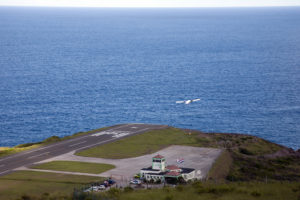 What a lift-off!
What a lift-off!
You'll know you're in for the ride of your life as your plane swings 180 degrees at the end of the runway to line up for lift-off. First, the deep blue of the Caribbean sea, then jagged cliffs and finally the end of the runway (that seems all too close!) will be imprinted on your mind. A roar of engines and you're off. But your worries are unfounded as you soar steeply into the sky leaving Saba behind and taking memories with you that will be shared for years to come.
Saba's Road
It's fair to say that not many places in the world can boast a road as an attraction. The Saba people challenge you to take a 30-minute drive on ‘The Road’ to understand why Saba lives up to its nickname: “The Unspoiled Queen”.
Buckle up when you depart Saba’s renowned airport and enter Zion's Hill (A.k.a. Hell’s Gate). As you wind and twist the chiseled cliff sides you may struggle to focus on the amazing panoramas of the neighboring islands, old fashion villages and varied seascapes. As you carve your way across the island, down the S-curve (pictured above and below), you find Saba’s point of commerce–it's only harbor–Fort Bay. Engage first gear to get back up to The Bottom (at 1,200 feet) in order to get down to your next stop, the elusive disappearing, reoccurring beach at Well's Bay.
Before The Road life on Saba was much tougher, Sabans faced the arduous task of traversing the island by trail, everything including the kitchen sink, pianos and monarchs were transported by hand and donkey through grueling elevations beneath the unforgiving Caribbean sun on twisting trails. In the late 1930's the decision to build a concrete road was made. Dutch & Swiss Civil Engineers deemed it a foolhardy task due to the island's extreme topography. Thus The Road got its title: "The Road that couldn't be built."
Building "The Road that couldn't be built".
 Josephus Lambert Hassell (A.k.a. Lambee) Luckily for the island it was left to a Saban to make the much-needed piece of infrastructure a reality. Josephus was a man who had issues with the word "couldn't". Challenged by the word he studied civil engineering by way of correspondence courses through the mail. In 1938, with the assistance of his fellow Sabans and no heavy machinery (yes it was all built by hand!) they got down to the business of the impossible. The vital access road from Fort Bay to The Bottom was completed within 5 years. This first stage of The Road was inaugurated in 1943. Four years later the first motor vehicle arrived.
Josephus Lambert Hassell (A.k.a. Lambee) Luckily for the island it was left to a Saban to make the much-needed piece of infrastructure a reality. Josephus was a man who had issues with the word "couldn't". Challenged by the word he studied civil engineering by way of correspondence courses through the mail. In 1938, with the assistance of his fellow Sabans and no heavy machinery (yes it was all built by hand!) they got down to the business of the impossible. The vital access road from Fort Bay to The Bottom was completed within 5 years. This first stage of The Road was inaugurated in 1943. Four years later the first motor vehicle arrived.
In 1951, The Road to Windwardside and St. John's was opened and seven years later The Road was completed. For two decades the islanders toiled to complete the project. Exercise caution before using the word “never” or the phrase "it can’t be done" within earshot of a Saban.
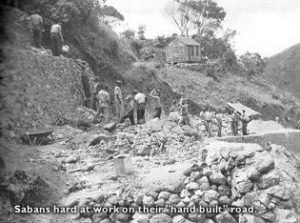 Driving The Road is an experience in itself. On your journey, a plethora of ecological zones await. Meandering from dry scrubland up to dense tropical vegetation, winding past many steep drop-offs as you go, the views are spectacular. Ascending the "Mountain Road", which ends at the Mt. Scenery trail, brings you to the highest point of The Road which is over 1800 feet above sea level. Don't be surprised while driving (or being driven) on Saba, to slip from bright warm sunshine into the cool mystical cloud.
Driving The Road is an experience in itself. On your journey, a plethora of ecological zones await. Meandering from dry scrubland up to dense tropical vegetation, winding past many steep drop-offs as you go, the views are spectacular. Ascending the "Mountain Road", which ends at the Mt. Scenery trail, brings you to the highest point of The Road which is over 1800 feet above sea level. Don't be surprised while driving (or being driven) on Saba, to slip from bright warm sunshine into the cool mystical cloud.
Hiking The Road can be strenuous but rewarding, just remember to keep to the outside of the curves and away from inner rock faces and walls when rounding corners to give traffic plenty of time to see you coming. If you run out of steam, take a seat on the wall and stick your thumb out. Before too long someone will stop and offer you a ride.
Getting Around on Saba
Upon your arrival at Saba's port or airport, you're sure to be greeted by a warm smile from one of Saba's taxi drivers. No worries they all know Saba like the back of their hands, whether you are staying at one of Saba's Hotels or a private residence they know where you need to go.
"The Road That Couldn't be Built" is a must-see! Travel the length of The Road in comfort with one of our friendly & knowledgeable taxi drivers. Click here for taxi rates.
Saba Taxi Drivers Phone & Mobile Numbers
| Taxi Number | Driver | Phone |
| Taxi # 1 | Cyril Hassell | +599 416-7166 |
| Taxi # 3 | Jermel Pond | +599 416-5074 / whatsapp # +590 690083859 |
| Taxi # 7 | Carmen Caines | +599 416-3330 / 416-6024 |
| Taxi # 9 | Peddy Johnson | +599 416-2345 / +1721 522 4999 |
| Taxi # 10 | Cornelius Richardson | +599 416-5764 |
| Taxi # 15 | Eric Granger | +599 416-6574 |
| Taxi # 16 | Joanna Hurthault | +599 416 5092/ +1 721 526 9093 |
| Taxi # 18 | Garvis Hassell | +599 416-6114 |
| Taxi # 19 | Cuchie Klabber | +1721 527-2520 / 416-6572 |
| Taxi # 27 | Rodney Swanepoel | +599 416-5971 |
On Call Drivers
| Name | Hours | Phone |
| Keith Johnson | 4:45 PM – 12:00 AM | +1721 526 9099 |
| Stanford Johnson | Can be called if no other taxis are available | +1 721 522 8877 / +599 416 2836 |
Car Rental
Morgan Car Rental and Car Wash
At Morgan Car Rental your booking experience is easy & convenient. Just call or email us to make your reservation. You can reach us on WhatsApp for free or call our U.S. number to avoid long distance charges.
Conveniently located at the Breadline Plaza in Windwardside.
Tel: 416 2881 0r 416 5893
email: info@icssaba.com
Richinel Riley
Tel +1721-5327293 or +599-4166132
or Trisha Peterson +599-4166026 email: rastayomi@hotmail.com
Email: trishapeterson22@hotmail.com
Exquis Car Rental
Judella Helyliger
Tel: +1721-5273434 or +1721-5881619
Email: exquiscar@gmail.com
Secrets Enterprises B.V
Tel: +1721 523 4114 or +1721 5560954
Email: reservations-secrets@hotmail.com
Hours: 8:00 AM - 5:00 PM
Top Tier Car Rental
Lisette Riley
Providing an exceptional car rental experience through top-tier service at an affordable price.
Location: The Bottom
Tel: +1 721 5815327
